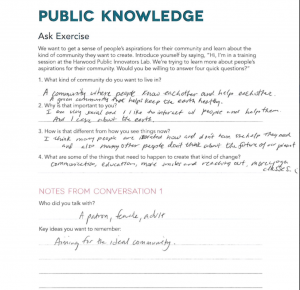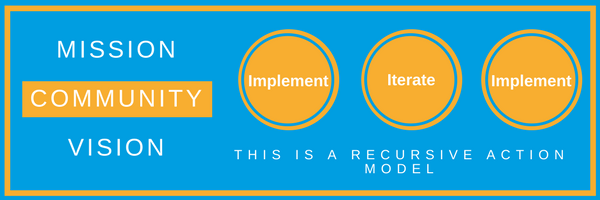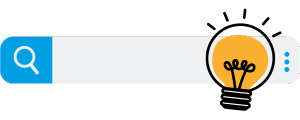Listening to your community is part of the daily activity of the library. As you begin your planning process, collecting data formally can happen through Community Conversations, Focus Groups, and Surveys. There also may be needs unspoken that can be identified by looking at demographic data.
We have found the Libraries Transforming Communities tools to be really useful in gathering what we call Public Knowledge – all the stuff the community knows about itself that the library can use to realign services with the community. Check out all the tools at the Turning Outward Resources for Libraries page.
Ask Exercise
Why do it: Empowering is the word we hear most from libraries who begin the planning process using the Ask Exercise. They feel empowered knowing the direction they chart is grounded in conversations they had with real people they serve.
Blanks: Libraries Transforming Communities Ask Exercise (.pdf); Example of Local Customization (.docx)
Tips for getting it done: Partner up! Just about no one is good at listening and writing at the same time. If partnering up simply isn’t an option, listen first and record later. Make a note that the recording happened after the listening.
You might be tempted to print these out and put them as written surveys around the community. Having conversations allow you to delve deeper into answers you weren’t quite sure about and demonstrate that your organization is actually listening to the community. It also gives you the ability to say at the end that you are using the information to inform the strategic planning process and to ask if they’d be interested in helping in the future.
Examples: 
Aspirations Exercise
Why do it: Motivating is the word the teams I’ve worked with use at the end of the Aspirations Exercise. At the end of a group working through each of the phases of co-creating the story of community work, they feel like a team focused on making their corner of the world a better place.
Blanks: Libraries Transforming Communities Aspirations Tool (pdf); Aspirations Facilitator’s Guide (pdf)
Tips for getting it done: Having two people for this helps too – one to listen, one to distill and facilitate. Careful that when you are recording what you hear to record what you actually hear – the actual words. Don’t be afraid to ask for clarification to ensure you’re capturing the good thinking in the room. As a facilitator, let silence be there so people have the space to speak – facilitate, but don’t guide. Also, be aware of who is and who is not speaking. Try, if possible, to engage all voices in the room.
Examples:
Our hope is to live in a community where everyone is thriving. However, right now we face a lack of jobs and other resources for healthy, happy, safe living. In order to get there as a community, we need to revitalize [Main] Street with commercial and cultural enterprise.
3rd Party Population Data
Does is support or refute your vision? Does it add dimension or complicate your resource searches?
Kids Wellness Indicator: This service gives
211 Counts: This service gives
Local & regional surveys conducted by area agencies & organizations:
Asset mapping
Why do it:
Blanks: In a facilitated conversation, we ask that the committee divide into two groups – one which will list out all the resources the community has, including agencies, organizations, active individuals, and geographic & natural resources; Some groups respond better to this more formal tool: Asset Mapping (.pdf)
Tips for getting it done:
Examples:
Community Conversation (World Cafe)
Why do it:
Blanks:
Tips for getting it done:
Examples:
Focus Groups
Why do it:
Blanks:
Tips for getting it done:
Examples:




 Visit our
Visit our  Check out the
Check out the